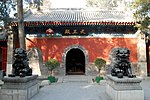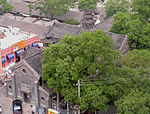Guang'anmennei station
Beijing Subway stations in Xicheng DistrictBeijing Subway stubsRailway stations in China opened in 2014

Guang'anmennei Station (simplified Chinese: 广安门内站; traditional Chinese: 廣安門內站; pinyin: Guǎng'ānménnèi Zhàn) is a station on Line 7 of the Beijing Subway. It was opened on December 28, 2014 as a part of the stretch between Beijing West railway station and Jiaohuachang and is located between Daguanying and Caishikou.
Excerpt from the Wikipedia article Guang'anmennei station (License: CC BY-SA 3.0, Authors, Images).Guang'anmennei station
Changchun Str, Xicheng District Guang'anmennei (首都功能核心区)
Geographical coordinates (GPS) Address Nearby Places Show on map
Geographical coordinates (GPS)
| Latitude | Longitude |
|---|---|
| N 39.8894 ° | E 116.3574 ° |
Address
牛街
Changchun Str
100032 Xicheng District, Guang'anmennei (首都功能核心区)
Beijing, China
Open on Google Maps











